The Continuous Disclosure Framework: An Australian Study
VerifiedAdded on 2020/05/28
|12
|2837
|467
Report
AI Summary
This report delves into the continuous disclosure framework in Australia, evaluating its efficacy in ensuring market transparency and investor protection. The report begins with an analysis of Bellamy's Australia Limited's financial situation, examining its cash flow, acquisitions, and income statements to highlight the importance of timely and accurate information disclosure. Part II focuses on the continuous disclosure regime, including its regulations, principles, and the role of the Australian Securities and Investment Commission (ASIC). It explores selective disclosure, insider trading, and ASIC's surveillance initiatives, concluding that while the framework is effective, continuous innovation from regulators is vital to maintain market integrity and investor confidence. The report emphasizes the need for a balance between timely information release and the protection of commercial interests, while also addressing the implications of selective briefings and the importance of equal access to information for all investors.
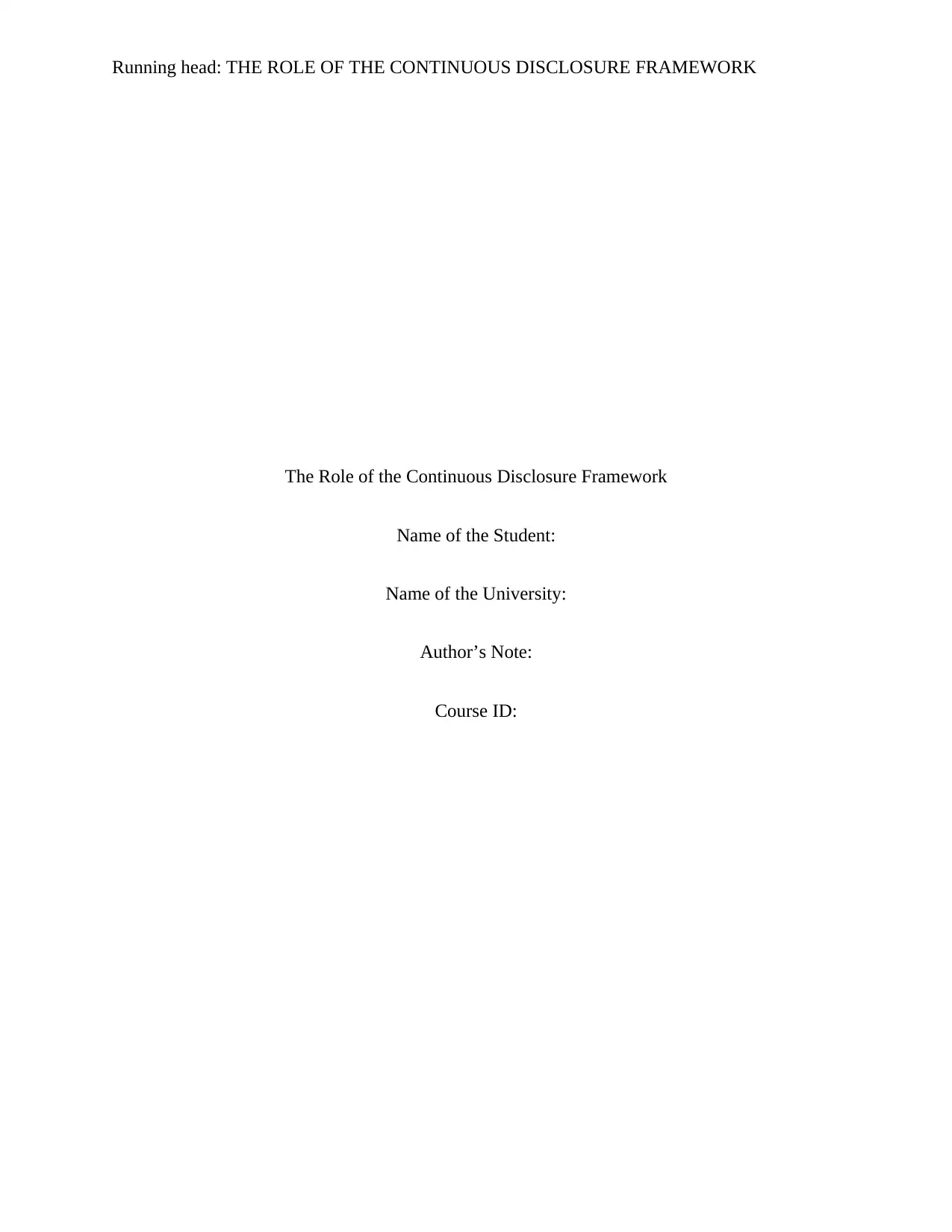
Running head: THE ROLE OF THE CONTINUOUS DISCLOSURE FRAMEWORK
The Role of the Continuous Disclosure Framework
Name of the Student:
Name of the University:
Author’s Note:
Course ID:
The Role of the Continuous Disclosure Framework
Name of the Student:
Name of the University:
Author’s Note:
Course ID:
Paraphrase This Document
Need a fresh take? Get an instant paraphrase of this document with our AI Paraphraser
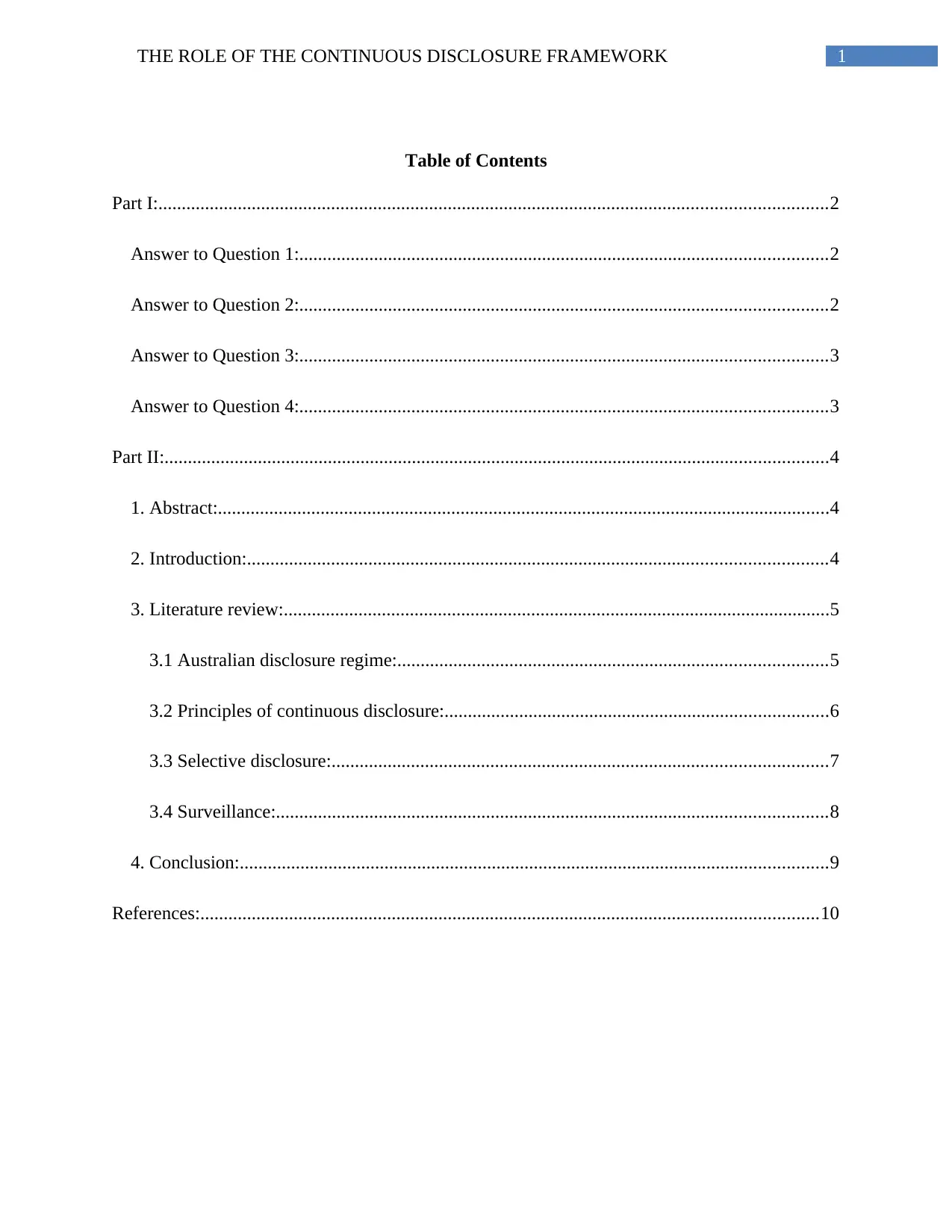
1THE ROLE OF THE CONTINUOUS DISCLOSURE FRAMEWORK
Table of Contents
Part I:...............................................................................................................................................2
Answer to Question 1:.................................................................................................................2
Answer to Question 2:.................................................................................................................2
Answer to Question 3:.................................................................................................................3
Answer to Question 4:.................................................................................................................3
Part II:..............................................................................................................................................4
1. Abstract:...................................................................................................................................4
2. Introduction:............................................................................................................................4
3. Literature review:.....................................................................................................................5
3.1 Australian disclosure regime:............................................................................................5
3.2 Principles of continuous disclosure:..................................................................................6
3.3 Selective disclosure:..........................................................................................................7
3.4 Surveillance:......................................................................................................................8
4. Conclusion:..............................................................................................................................9
References:....................................................................................................................................10
Table of Contents
Part I:...............................................................................................................................................2
Answer to Question 1:.................................................................................................................2
Answer to Question 2:.................................................................................................................2
Answer to Question 3:.................................................................................................................3
Answer to Question 4:.................................................................................................................3
Part II:..............................................................................................................................................4
1. Abstract:...................................................................................................................................4
2. Introduction:............................................................................................................................4
3. Literature review:.....................................................................................................................5
3.1 Australian disclosure regime:............................................................................................5
3.2 Principles of continuous disclosure:..................................................................................6
3.3 Selective disclosure:..........................................................................................................7
3.4 Surveillance:......................................................................................................................8
4. Conclusion:..............................................................................................................................9
References:....................................................................................................................................10
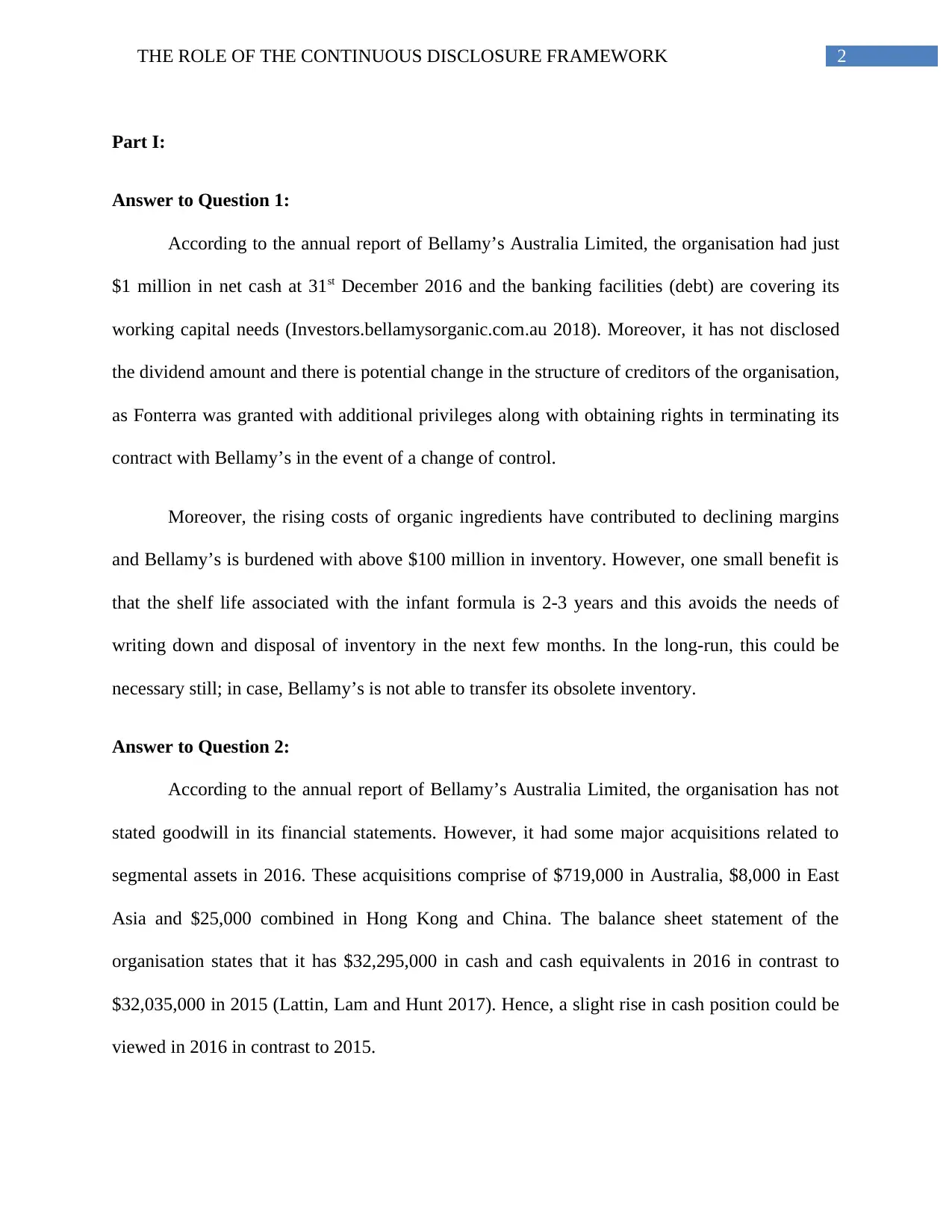
2THE ROLE OF THE CONTINUOUS DISCLOSURE FRAMEWORK
Part I:
Answer to Question 1:
According to the annual report of Bellamy’s Australia Limited, the organisation had just
$1 million in net cash at 31st December 2016 and the banking facilities (debt) are covering its
working capital needs (Investors.bellamysorganic.com.au 2018). Moreover, it has not disclosed
the dividend amount and there is potential change in the structure of creditors of the organisation,
as Fonterra was granted with additional privileges along with obtaining rights in terminating its
contract with Bellamy’s in the event of a change of control.
Moreover, the rising costs of organic ingredients have contributed to declining margins
and Bellamy’s is burdened with above $100 million in inventory. However, one small benefit is
that the shelf life associated with the infant formula is 2-3 years and this avoids the needs of
writing down and disposal of inventory in the next few months. In the long-run, this could be
necessary still; in case, Bellamy’s is not able to transfer its obsolete inventory.
Answer to Question 2:
According to the annual report of Bellamy’s Australia Limited, the organisation has not
stated goodwill in its financial statements. However, it had some major acquisitions related to
segmental assets in 2016. These acquisitions comprise of $719,000 in Australia, $8,000 in East
Asia and $25,000 combined in Hong Kong and China. The balance sheet statement of the
organisation states that it has $32,295,000 in cash and cash equivalents in 2016 in contrast to
$32,035,000 in 2015 (Lattin, Lam and Hunt 2017). Hence, a slight rise in cash position could be
viewed in 2016 in contrast to 2015.
Part I:
Answer to Question 1:
According to the annual report of Bellamy’s Australia Limited, the organisation had just
$1 million in net cash at 31st December 2016 and the banking facilities (debt) are covering its
working capital needs (Investors.bellamysorganic.com.au 2018). Moreover, it has not disclosed
the dividend amount and there is potential change in the structure of creditors of the organisation,
as Fonterra was granted with additional privileges along with obtaining rights in terminating its
contract with Bellamy’s in the event of a change of control.
Moreover, the rising costs of organic ingredients have contributed to declining margins
and Bellamy’s is burdened with above $100 million in inventory. However, one small benefit is
that the shelf life associated with the infant formula is 2-3 years and this avoids the needs of
writing down and disposal of inventory in the next few months. In the long-run, this could be
necessary still; in case, Bellamy’s is not able to transfer its obsolete inventory.
Answer to Question 2:
According to the annual report of Bellamy’s Australia Limited, the organisation has not
stated goodwill in its financial statements. However, it had some major acquisitions related to
segmental assets in 2016. These acquisitions comprise of $719,000 in Australia, $8,000 in East
Asia and $25,000 combined in Hong Kong and China. The balance sheet statement of the
organisation states that it has $32,295,000 in cash and cash equivalents in 2016 in contrast to
$32,035,000 in 2015 (Lattin, Lam and Hunt 2017). Hence, a slight rise in cash position could be
viewed in 2016 in contrast to 2015.
⊘ This is a preview!⊘
Do you want full access?
Subscribe today to unlock all pages.

Trusted by 1+ million students worldwide
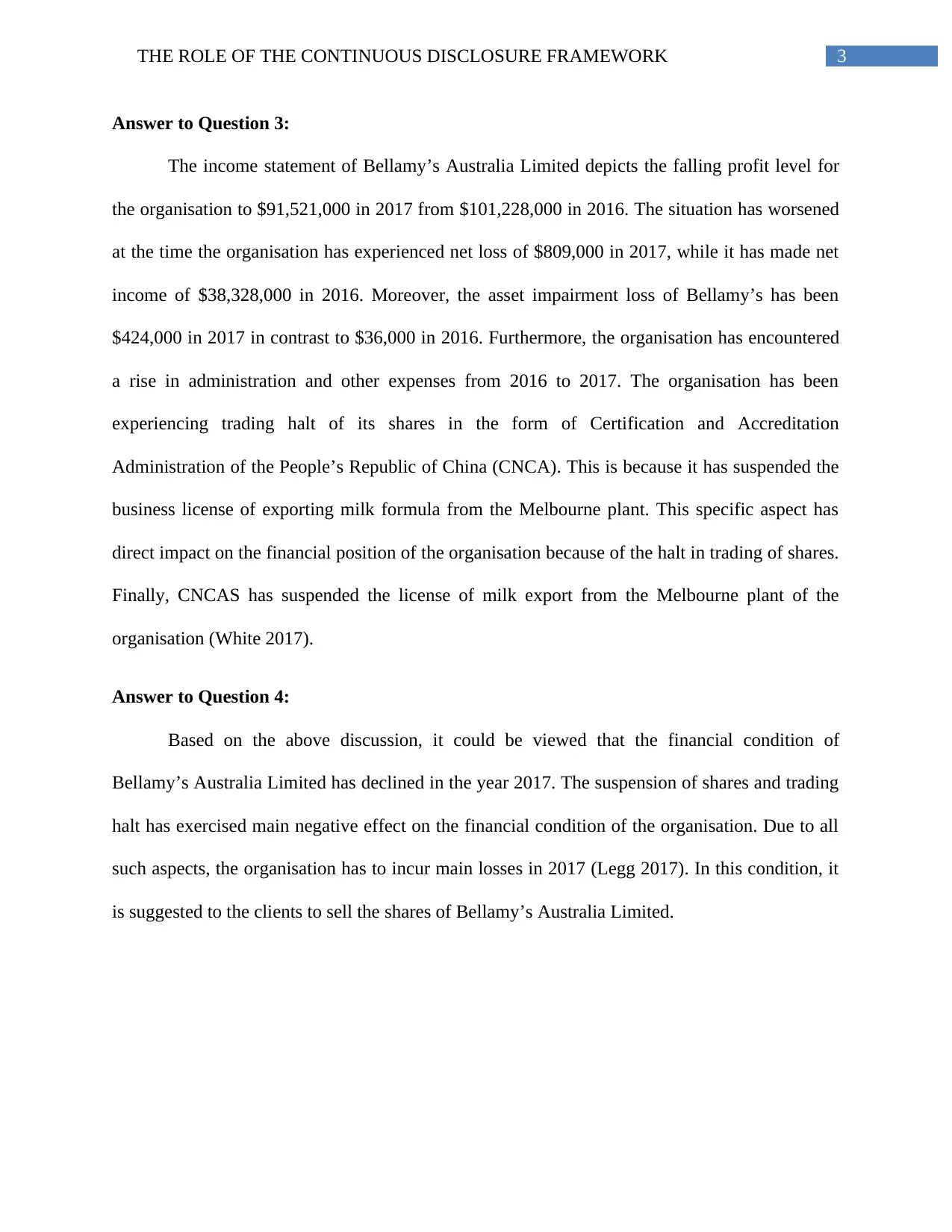
3THE ROLE OF THE CONTINUOUS DISCLOSURE FRAMEWORK
Answer to Question 3:
The income statement of Bellamy’s Australia Limited depicts the falling profit level for
the organisation to $91,521,000 in 2017 from $101,228,000 in 2016. The situation has worsened
at the time the organisation has experienced net loss of $809,000 in 2017, while it has made net
income of $38,328,000 in 2016. Moreover, the asset impairment loss of Bellamy’s has been
$424,000 in 2017 in contrast to $36,000 in 2016. Furthermore, the organisation has encountered
a rise in administration and other expenses from 2016 to 2017. The organisation has been
experiencing trading halt of its shares in the form of Certification and Accreditation
Administration of the People’s Republic of China (CNCA). This is because it has suspended the
business license of exporting milk formula from the Melbourne plant. This specific aspect has
direct impact on the financial position of the organisation because of the halt in trading of shares.
Finally, CNCAS has suspended the license of milk export from the Melbourne plant of the
organisation (White 2017).
Answer to Question 4:
Based on the above discussion, it could be viewed that the financial condition of
Bellamy’s Australia Limited has declined in the year 2017. The suspension of shares and trading
halt has exercised main negative effect on the financial condition of the organisation. Due to all
such aspects, the organisation has to incur main losses in 2017 (Legg 2017). In this condition, it
is suggested to the clients to sell the shares of Bellamy’s Australia Limited.
Answer to Question 3:
The income statement of Bellamy’s Australia Limited depicts the falling profit level for
the organisation to $91,521,000 in 2017 from $101,228,000 in 2016. The situation has worsened
at the time the organisation has experienced net loss of $809,000 in 2017, while it has made net
income of $38,328,000 in 2016. Moreover, the asset impairment loss of Bellamy’s has been
$424,000 in 2017 in contrast to $36,000 in 2016. Furthermore, the organisation has encountered
a rise in administration and other expenses from 2016 to 2017. The organisation has been
experiencing trading halt of its shares in the form of Certification and Accreditation
Administration of the People’s Republic of China (CNCA). This is because it has suspended the
business license of exporting milk formula from the Melbourne plant. This specific aspect has
direct impact on the financial position of the organisation because of the halt in trading of shares.
Finally, CNCAS has suspended the license of milk export from the Melbourne plant of the
organisation (White 2017).
Answer to Question 4:
Based on the above discussion, it could be viewed that the financial condition of
Bellamy’s Australia Limited has declined in the year 2017. The suspension of shares and trading
halt has exercised main negative effect on the financial condition of the organisation. Due to all
such aspects, the organisation has to incur main losses in 2017 (Legg 2017). In this condition, it
is suggested to the clients to sell the shares of Bellamy’s Australia Limited.
Paraphrase This Document
Need a fresh take? Get an instant paraphrase of this document with our AI Paraphraser
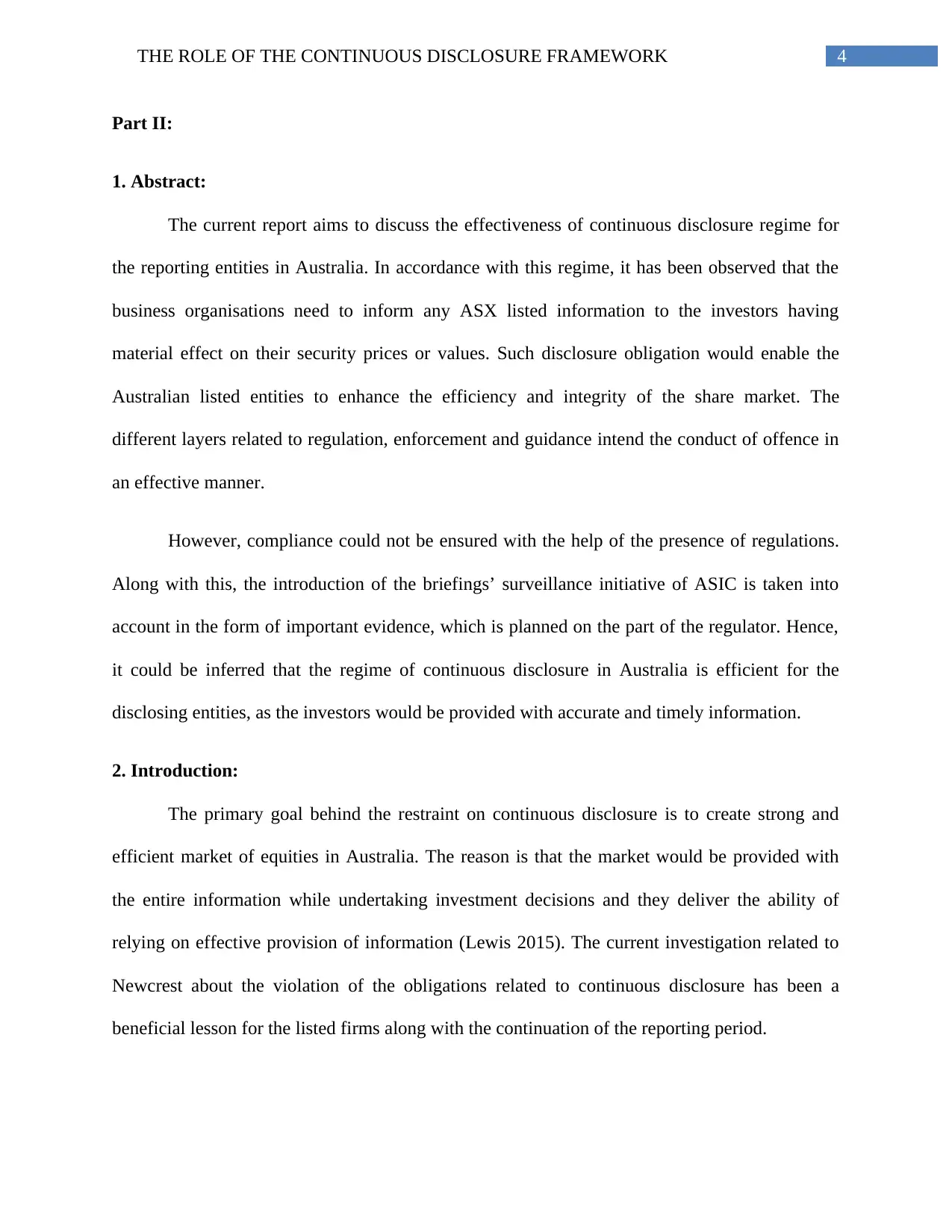
4THE ROLE OF THE CONTINUOUS DISCLOSURE FRAMEWORK
Part II:
1. Abstract:
The current report aims to discuss the effectiveness of continuous disclosure regime for
the reporting entities in Australia. In accordance with this regime, it has been observed that the
business organisations need to inform any ASX listed information to the investors having
material effect on their security prices or values. Such disclosure obligation would enable the
Australian listed entities to enhance the efficiency and integrity of the share market. The
different layers related to regulation, enforcement and guidance intend the conduct of offence in
an effective manner.
However, compliance could not be ensured with the help of the presence of regulations.
Along with this, the introduction of the briefings’ surveillance initiative of ASIC is taken into
account in the form of important evidence, which is planned on the part of the regulator. Hence,
it could be inferred that the regime of continuous disclosure in Australia is efficient for the
disclosing entities, as the investors would be provided with accurate and timely information.
2. Introduction:
The primary goal behind the restraint on continuous disclosure is to create strong and
efficient market of equities in Australia. The reason is that the market would be provided with
the entire information while undertaking investment decisions and they deliver the ability of
relying on effective provision of information (Lewis 2015). The current investigation related to
Newcrest about the violation of the obligations related to continuous disclosure has been a
beneficial lesson for the listed firms along with the continuation of the reporting period.
Part II:
1. Abstract:
The current report aims to discuss the effectiveness of continuous disclosure regime for
the reporting entities in Australia. In accordance with this regime, it has been observed that the
business organisations need to inform any ASX listed information to the investors having
material effect on their security prices or values. Such disclosure obligation would enable the
Australian listed entities to enhance the efficiency and integrity of the share market. The
different layers related to regulation, enforcement and guidance intend the conduct of offence in
an effective manner.
However, compliance could not be ensured with the help of the presence of regulations.
Along with this, the introduction of the briefings’ surveillance initiative of ASIC is taken into
account in the form of important evidence, which is planned on the part of the regulator. Hence,
it could be inferred that the regime of continuous disclosure in Australia is efficient for the
disclosing entities, as the investors would be provided with accurate and timely information.
2. Introduction:
The primary goal behind the restraint on continuous disclosure is to create strong and
efficient market of equities in Australia. The reason is that the market would be provided with
the entire information while undertaking investment decisions and they deliver the ability of
relying on effective provision of information (Lewis 2015). The current investigation related to
Newcrest about the violation of the obligations related to continuous disclosure has been a
beneficial lesson for the listed firms along with the continuation of the reporting period.
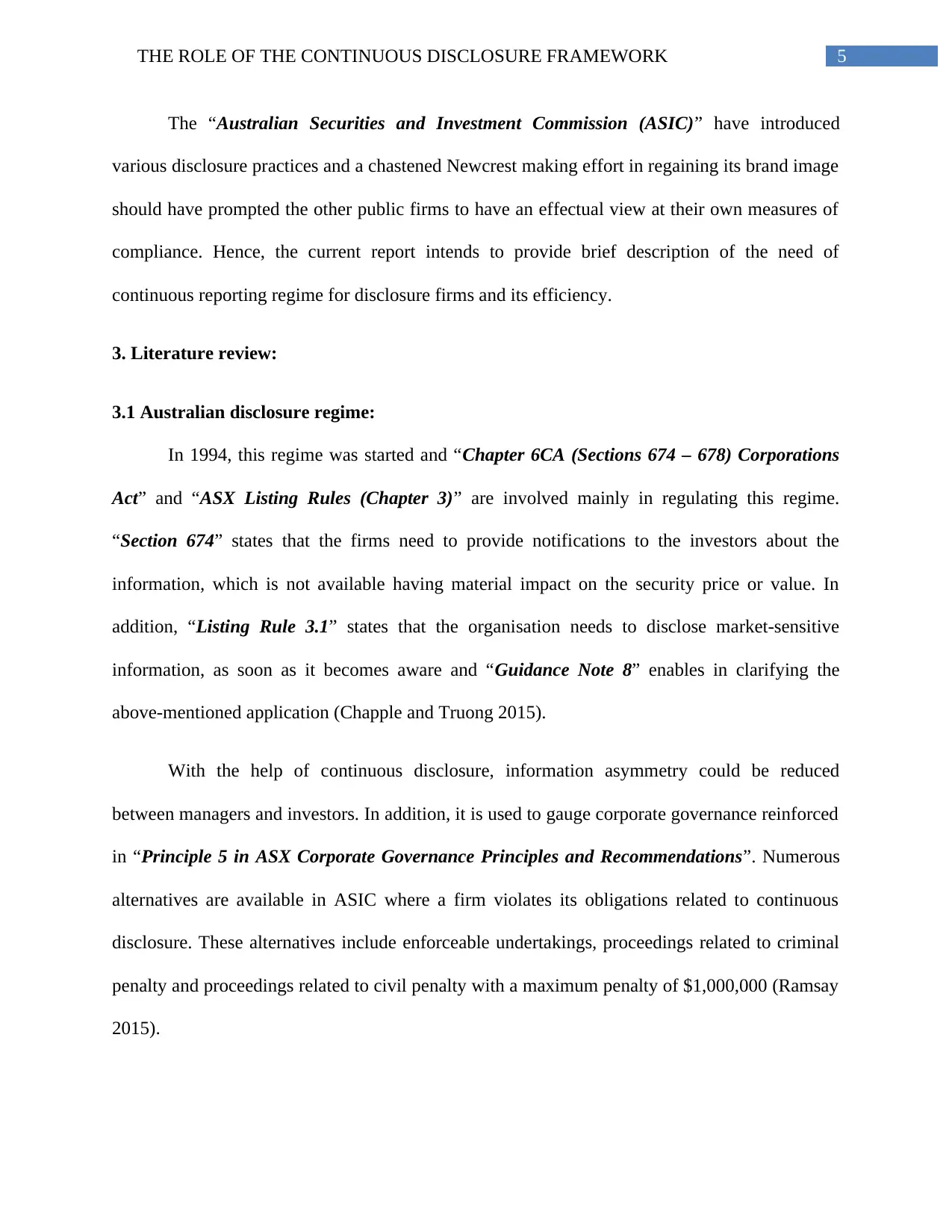
5THE ROLE OF THE CONTINUOUS DISCLOSURE FRAMEWORK
The “Australian Securities and Investment Commission (ASIC)” have introduced
various disclosure practices and a chastened Newcrest making effort in regaining its brand image
should have prompted the other public firms to have an effectual view at their own measures of
compliance. Hence, the current report intends to provide brief description of the need of
continuous reporting regime for disclosure firms and its efficiency.
3. Literature review:
3.1 Australian disclosure regime:
In 1994, this regime was started and “Chapter 6CA (Sections 674 – 678) Corporations
Act” and “ASX Listing Rules (Chapter 3)” are involved mainly in regulating this regime.
“Section 674” states that the firms need to provide notifications to the investors about the
information, which is not available having material impact on the security price or value. In
addition, “Listing Rule 3.1” states that the organisation needs to disclose market-sensitive
information, as soon as it becomes aware and “Guidance Note 8” enables in clarifying the
above-mentioned application (Chapple and Truong 2015).
With the help of continuous disclosure, information asymmetry could be reduced
between managers and investors. In addition, it is used to gauge corporate governance reinforced
in “Principle 5 in ASX Corporate Governance Principles and Recommendations”. Numerous
alternatives are available in ASIC where a firm violates its obligations related to continuous
disclosure. These alternatives include enforceable undertakings, proceedings related to criminal
penalty and proceedings related to civil penalty with a maximum penalty of $1,000,000 (Ramsay
2015).
The “Australian Securities and Investment Commission (ASIC)” have introduced
various disclosure practices and a chastened Newcrest making effort in regaining its brand image
should have prompted the other public firms to have an effectual view at their own measures of
compliance. Hence, the current report intends to provide brief description of the need of
continuous reporting regime for disclosure firms and its efficiency.
3. Literature review:
3.1 Australian disclosure regime:
In 1994, this regime was started and “Chapter 6CA (Sections 674 – 678) Corporations
Act” and “ASX Listing Rules (Chapter 3)” are involved mainly in regulating this regime.
“Section 674” states that the firms need to provide notifications to the investors about the
information, which is not available having material impact on the security price or value. In
addition, “Listing Rule 3.1” states that the organisation needs to disclose market-sensitive
information, as soon as it becomes aware and “Guidance Note 8” enables in clarifying the
above-mentioned application (Chapple and Truong 2015).
With the help of continuous disclosure, information asymmetry could be reduced
between managers and investors. In addition, it is used to gauge corporate governance reinforced
in “Principle 5 in ASX Corporate Governance Principles and Recommendations”. Numerous
alternatives are available in ASIC where a firm violates its obligations related to continuous
disclosure. These alternatives include enforceable undertakings, proceedings related to criminal
penalty and proceedings related to civil penalty with a maximum penalty of $1,000,000 (Ramsay
2015).
⊘ This is a preview!⊘
Do you want full access?
Subscribe today to unlock all pages.

Trusted by 1+ million students worldwide
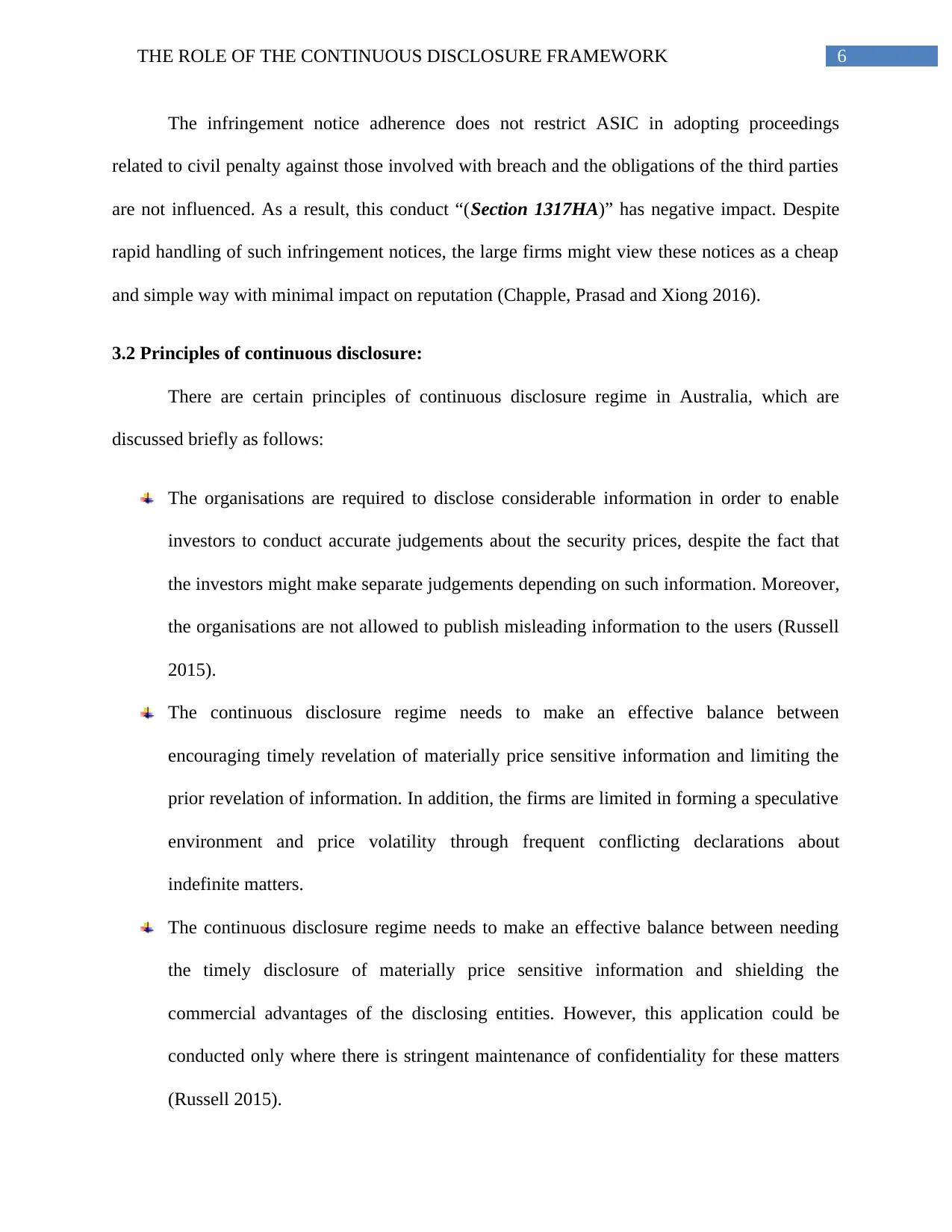
6THE ROLE OF THE CONTINUOUS DISCLOSURE FRAMEWORK
The infringement notice adherence does not restrict ASIC in adopting proceedings
related to civil penalty against those involved with breach and the obligations of the third parties
are not influenced. As a result, this conduct “(Section 1317HA)” has negative impact. Despite
rapid handling of such infringement notices, the large firms might view these notices as a cheap
and simple way with minimal impact on reputation (Chapple, Prasad and Xiong 2016).
3.2 Principles of continuous disclosure:
There are certain principles of continuous disclosure regime in Australia, which are
discussed briefly as follows:
The organisations are required to disclose considerable information in order to enable
investors to conduct accurate judgements about the security prices, despite the fact that
the investors might make separate judgements depending on such information. Moreover,
the organisations are not allowed to publish misleading information to the users (Russell
2015).
The continuous disclosure regime needs to make an effective balance between
encouraging timely revelation of materially price sensitive information and limiting the
prior revelation of information. In addition, the firms are limited in forming a speculative
environment and price volatility through frequent conflicting declarations about
indefinite matters.
The continuous disclosure regime needs to make an effective balance between needing
the timely disclosure of materially price sensitive information and shielding the
commercial advantages of the disclosing entities. However, this application could be
conducted only where there is stringent maintenance of confidentiality for these matters
(Russell 2015).
The infringement notice adherence does not restrict ASIC in adopting proceedings
related to civil penalty against those involved with breach and the obligations of the third parties
are not influenced. As a result, this conduct “(Section 1317HA)” has negative impact. Despite
rapid handling of such infringement notices, the large firms might view these notices as a cheap
and simple way with minimal impact on reputation (Chapple, Prasad and Xiong 2016).
3.2 Principles of continuous disclosure:
There are certain principles of continuous disclosure regime in Australia, which are
discussed briefly as follows:
The organisations are required to disclose considerable information in order to enable
investors to conduct accurate judgements about the security prices, despite the fact that
the investors might make separate judgements depending on such information. Moreover,
the organisations are not allowed to publish misleading information to the users (Russell
2015).
The continuous disclosure regime needs to make an effective balance between
encouraging timely revelation of materially price sensitive information and limiting the
prior revelation of information. In addition, the firms are limited in forming a speculative
environment and price volatility through frequent conflicting declarations about
indefinite matters.
The continuous disclosure regime needs to make an effective balance between needing
the timely disclosure of materially price sensitive information and shielding the
commercial advantages of the disclosing entities. However, this application could be
conducted only where there is stringent maintenance of confidentiality for these matters
(Russell 2015).
Paraphrase This Document
Need a fresh take? Get an instant paraphrase of this document with our AI Paraphraser
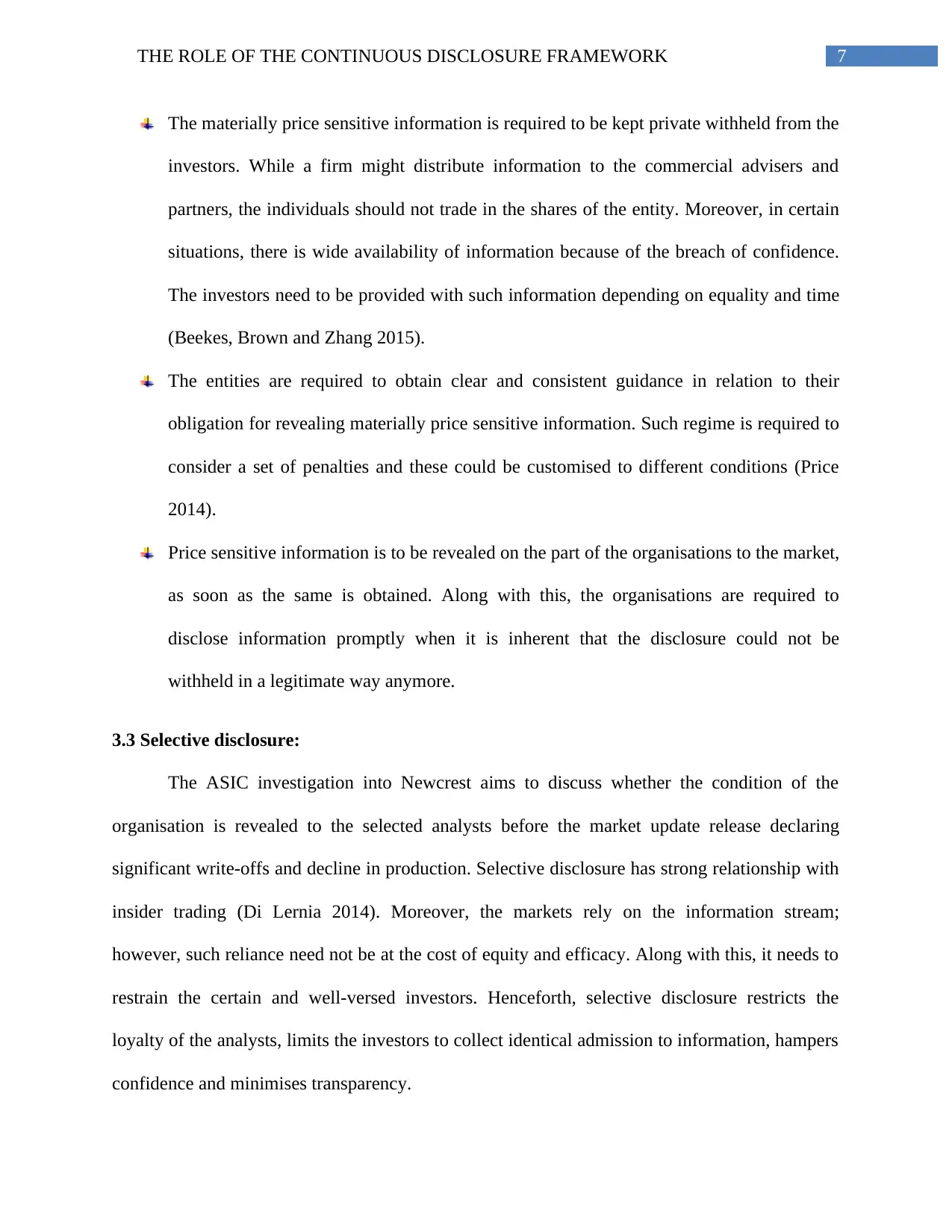
7THE ROLE OF THE CONTINUOUS DISCLOSURE FRAMEWORK
The materially price sensitive information is required to be kept private withheld from the
investors. While a firm might distribute information to the commercial advisers and
partners, the individuals should not trade in the shares of the entity. Moreover, in certain
situations, there is wide availability of information because of the breach of confidence.
The investors need to be provided with such information depending on equality and time
(Beekes, Brown and Zhang 2015).
The entities are required to obtain clear and consistent guidance in relation to their
obligation for revealing materially price sensitive information. Such regime is required to
consider a set of penalties and these could be customised to different conditions (Price
2014).
Price sensitive information is to be revealed on the part of the organisations to the market,
as soon as the same is obtained. Along with this, the organisations are required to
disclose information promptly when it is inherent that the disclosure could not be
withheld in a legitimate way anymore.
3.3 Selective disclosure:
The ASIC investigation into Newcrest aims to discuss whether the condition of the
organisation is revealed to the selected analysts before the market update release declaring
significant write-offs and decline in production. Selective disclosure has strong relationship with
insider trading (Di Lernia 2014). Moreover, the markets rely on the information stream;
however, such reliance need not be at the cost of equity and efficacy. Along with this, it needs to
restrain the certain and well-versed investors. Henceforth, selective disclosure restricts the
loyalty of the analysts, limits the investors to collect identical admission to information, hampers
confidence and minimises transparency.
The materially price sensitive information is required to be kept private withheld from the
investors. While a firm might distribute information to the commercial advisers and
partners, the individuals should not trade in the shares of the entity. Moreover, in certain
situations, there is wide availability of information because of the breach of confidence.
The investors need to be provided with such information depending on equality and time
(Beekes, Brown and Zhang 2015).
The entities are required to obtain clear and consistent guidance in relation to their
obligation for revealing materially price sensitive information. Such regime is required to
consider a set of penalties and these could be customised to different conditions (Price
2014).
Price sensitive information is to be revealed on the part of the organisations to the market,
as soon as the same is obtained. Along with this, the organisations are required to
disclose information promptly when it is inherent that the disclosure could not be
withheld in a legitimate way anymore.
3.3 Selective disclosure:
The ASIC investigation into Newcrest aims to discuss whether the condition of the
organisation is revealed to the selected analysts before the market update release declaring
significant write-offs and decline in production. Selective disclosure has strong relationship with
insider trading (Di Lernia 2014). Moreover, the markets rely on the information stream;
however, such reliance need not be at the cost of equity and efficacy. Along with this, it needs to
restrain the certain and well-versed investors. Henceforth, selective disclosure restricts the
loyalty of the analysts, limits the investors to collect identical admission to information, hampers
confidence and minimises transparency.
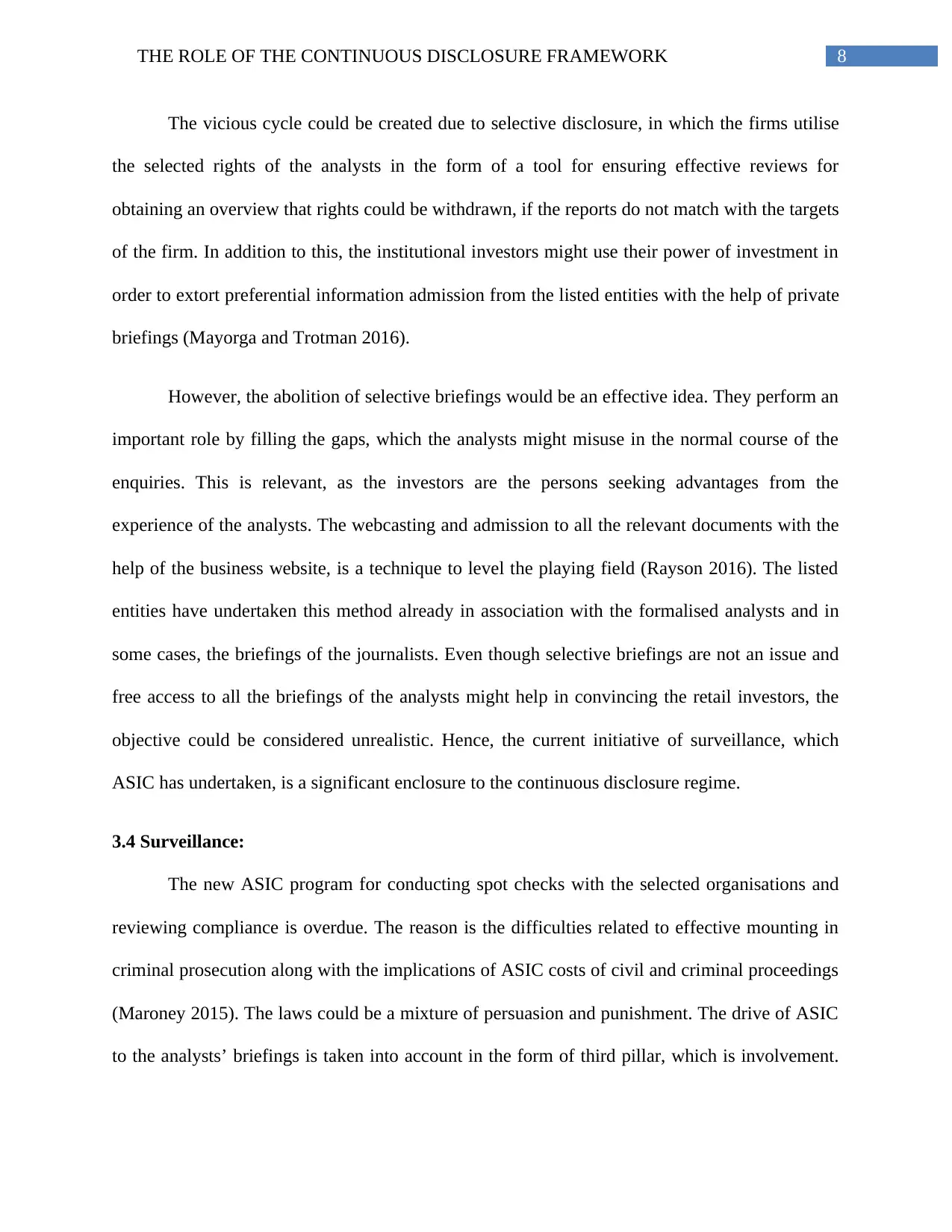
8THE ROLE OF THE CONTINUOUS DISCLOSURE FRAMEWORK
The vicious cycle could be created due to selective disclosure, in which the firms utilise
the selected rights of the analysts in the form of a tool for ensuring effective reviews for
obtaining an overview that rights could be withdrawn, if the reports do not match with the targets
of the firm. In addition to this, the institutional investors might use their power of investment in
order to extort preferential information admission from the listed entities with the help of private
briefings (Mayorga and Trotman 2016).
However, the abolition of selective briefings would be an effective idea. They perform an
important role by filling the gaps, which the analysts might misuse in the normal course of the
enquiries. This is relevant, as the investors are the persons seeking advantages from the
experience of the analysts. The webcasting and admission to all the relevant documents with the
help of the business website, is a technique to level the playing field (Rayson 2016). The listed
entities have undertaken this method already in association with the formalised analysts and in
some cases, the briefings of the journalists. Even though selective briefings are not an issue and
free access to all the briefings of the analysts might help in convincing the retail investors, the
objective could be considered unrealistic. Hence, the current initiative of surveillance, which
ASIC has undertaken, is a significant enclosure to the continuous disclosure regime.
3.4 Surveillance:
The new ASIC program for conducting spot checks with the selected organisations and
reviewing compliance is overdue. The reason is the difficulties related to effective mounting in
criminal prosecution along with the implications of ASIC costs of civil and criminal proceedings
(Maroney 2015). The laws could be a mixture of persuasion and punishment. The drive of ASIC
to the analysts’ briefings is taken into account in the form of third pillar, which is involvement.
The vicious cycle could be created due to selective disclosure, in which the firms utilise
the selected rights of the analysts in the form of a tool for ensuring effective reviews for
obtaining an overview that rights could be withdrawn, if the reports do not match with the targets
of the firm. In addition to this, the institutional investors might use their power of investment in
order to extort preferential information admission from the listed entities with the help of private
briefings (Mayorga and Trotman 2016).
However, the abolition of selective briefings would be an effective idea. They perform an
important role by filling the gaps, which the analysts might misuse in the normal course of the
enquiries. This is relevant, as the investors are the persons seeking advantages from the
experience of the analysts. The webcasting and admission to all the relevant documents with the
help of the business website, is a technique to level the playing field (Rayson 2016). The listed
entities have undertaken this method already in association with the formalised analysts and in
some cases, the briefings of the journalists. Even though selective briefings are not an issue and
free access to all the briefings of the analysts might help in convincing the retail investors, the
objective could be considered unrealistic. Hence, the current initiative of surveillance, which
ASIC has undertaken, is a significant enclosure to the continuous disclosure regime.
3.4 Surveillance:
The new ASIC program for conducting spot checks with the selected organisations and
reviewing compliance is overdue. The reason is the difficulties related to effective mounting in
criminal prosecution along with the implications of ASIC costs of civil and criminal proceedings
(Maroney 2015). The laws could be a mixture of persuasion and punishment. The drive of ASIC
to the analysts’ briefings is taken into account in the form of third pillar, which is involvement.
⊘ This is a preview!⊘
Do you want full access?
Subscribe today to unlock all pages.

Trusted by 1+ million students worldwide
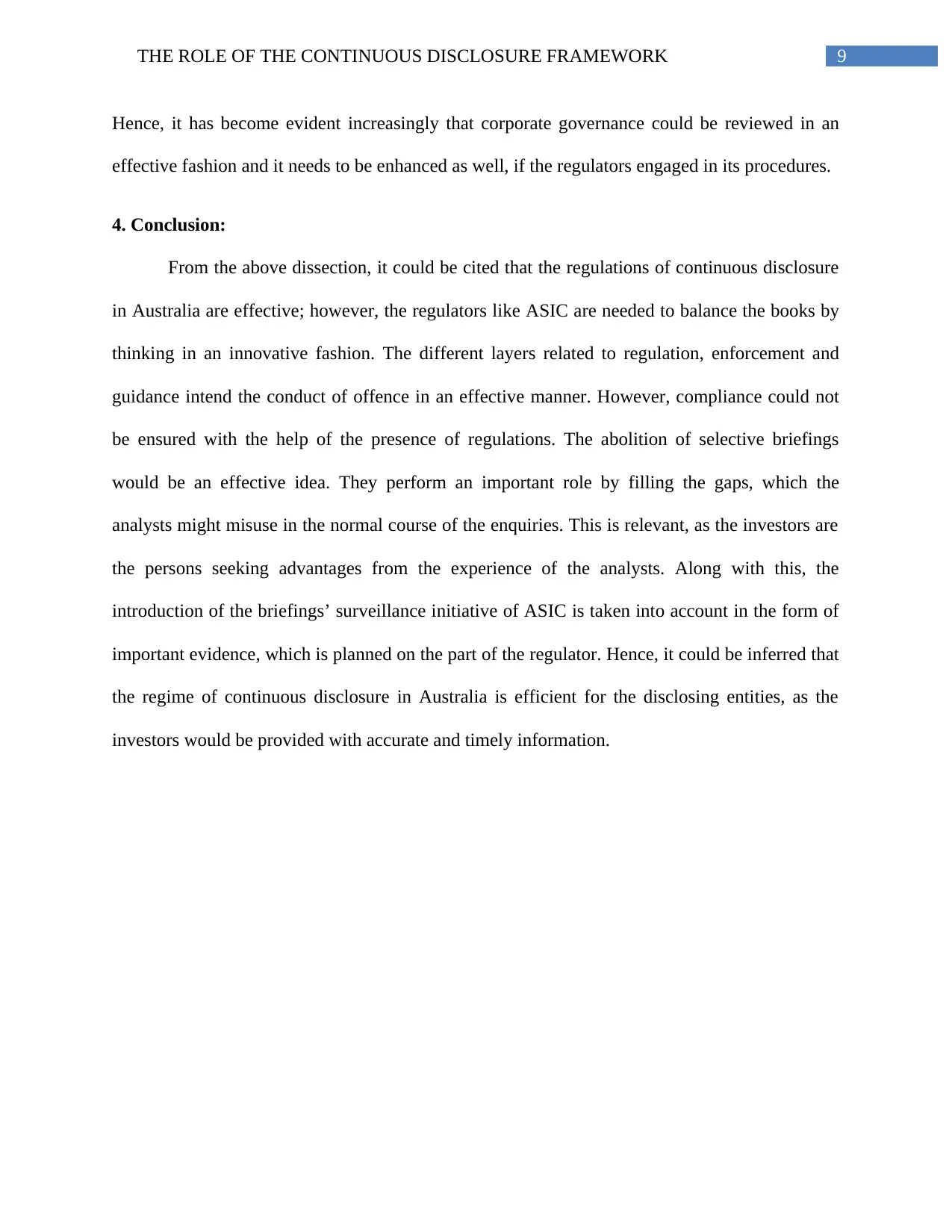
9THE ROLE OF THE CONTINUOUS DISCLOSURE FRAMEWORK
Hence, it has become evident increasingly that corporate governance could be reviewed in an
effective fashion and it needs to be enhanced as well, if the regulators engaged in its procedures.
4. Conclusion:
From the above dissection, it could be cited that the regulations of continuous disclosure
in Australia are effective; however, the regulators like ASIC are needed to balance the books by
thinking in an innovative fashion. The different layers related to regulation, enforcement and
guidance intend the conduct of offence in an effective manner. However, compliance could not
be ensured with the help of the presence of regulations. The abolition of selective briefings
would be an effective idea. They perform an important role by filling the gaps, which the
analysts might misuse in the normal course of the enquiries. This is relevant, as the investors are
the persons seeking advantages from the experience of the analysts. Along with this, the
introduction of the briefings’ surveillance initiative of ASIC is taken into account in the form of
important evidence, which is planned on the part of the regulator. Hence, it could be inferred that
the regime of continuous disclosure in Australia is efficient for the disclosing entities, as the
investors would be provided with accurate and timely information.
Hence, it has become evident increasingly that corporate governance could be reviewed in an
effective fashion and it needs to be enhanced as well, if the regulators engaged in its procedures.
4. Conclusion:
From the above dissection, it could be cited that the regulations of continuous disclosure
in Australia are effective; however, the regulators like ASIC are needed to balance the books by
thinking in an innovative fashion. The different layers related to regulation, enforcement and
guidance intend the conduct of offence in an effective manner. However, compliance could not
be ensured with the help of the presence of regulations. The abolition of selective briefings
would be an effective idea. They perform an important role by filling the gaps, which the
analysts might misuse in the normal course of the enquiries. This is relevant, as the investors are
the persons seeking advantages from the experience of the analysts. Along with this, the
introduction of the briefings’ surveillance initiative of ASIC is taken into account in the form of
important evidence, which is planned on the part of the regulator. Hence, it could be inferred that
the regime of continuous disclosure in Australia is efficient for the disclosing entities, as the
investors would be provided with accurate and timely information.
Paraphrase This Document
Need a fresh take? Get an instant paraphrase of this document with our AI Paraphraser
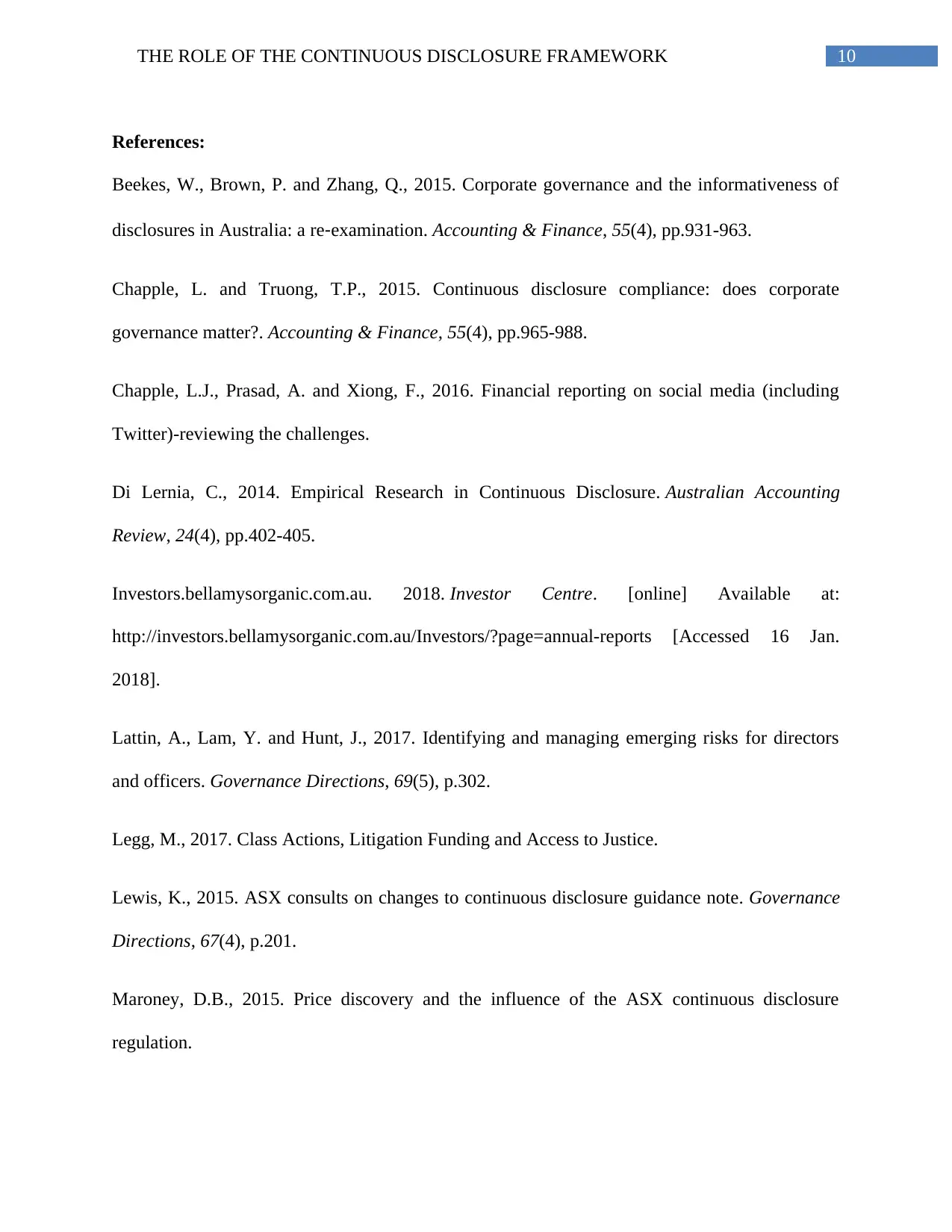
10THE ROLE OF THE CONTINUOUS DISCLOSURE FRAMEWORK
References:
Beekes, W., Brown, P. and Zhang, Q., 2015. Corporate governance and the informativeness of
disclosures in Australia: a re‐examination. Accounting & Finance, 55(4), pp.931-963.
Chapple, L. and Truong, T.P., 2015. Continuous disclosure compliance: does corporate
governance matter?. Accounting & Finance, 55(4), pp.965-988.
Chapple, L.J., Prasad, A. and Xiong, F., 2016. Financial reporting on social media (including
Twitter)-reviewing the challenges.
Di Lernia, C., 2014. Empirical Research in Continuous Disclosure. Australian Accounting
Review, 24(4), pp.402-405.
Investors.bellamysorganic.com.au. 2018. Investor Centre. [online] Available at:
http://investors.bellamysorganic.com.au/Investors/?page=annual-reports [Accessed 16 Jan.
2018].
Lattin, A., Lam, Y. and Hunt, J., 2017. Identifying and managing emerging risks for directors
and officers. Governance Directions, 69(5), p.302.
Legg, M., 2017. Class Actions, Litigation Funding and Access to Justice.
Lewis, K., 2015. ASX consults on changes to continuous disclosure guidance note. Governance
Directions, 67(4), p.201.
Maroney, D.B., 2015. Price discovery and the influence of the ASX continuous disclosure
regulation.
References:
Beekes, W., Brown, P. and Zhang, Q., 2015. Corporate governance and the informativeness of
disclosures in Australia: a re‐examination. Accounting & Finance, 55(4), pp.931-963.
Chapple, L. and Truong, T.P., 2015. Continuous disclosure compliance: does corporate
governance matter?. Accounting & Finance, 55(4), pp.965-988.
Chapple, L.J., Prasad, A. and Xiong, F., 2016. Financial reporting on social media (including
Twitter)-reviewing the challenges.
Di Lernia, C., 2014. Empirical Research in Continuous Disclosure. Australian Accounting
Review, 24(4), pp.402-405.
Investors.bellamysorganic.com.au. 2018. Investor Centre. [online] Available at:
http://investors.bellamysorganic.com.au/Investors/?page=annual-reports [Accessed 16 Jan.
2018].
Lattin, A., Lam, Y. and Hunt, J., 2017. Identifying and managing emerging risks for directors
and officers. Governance Directions, 69(5), p.302.
Legg, M., 2017. Class Actions, Litigation Funding and Access to Justice.
Lewis, K., 2015. ASX consults on changes to continuous disclosure guidance note. Governance
Directions, 67(4), p.201.
Maroney, D.B., 2015. Price discovery and the influence of the ASX continuous disclosure
regulation.
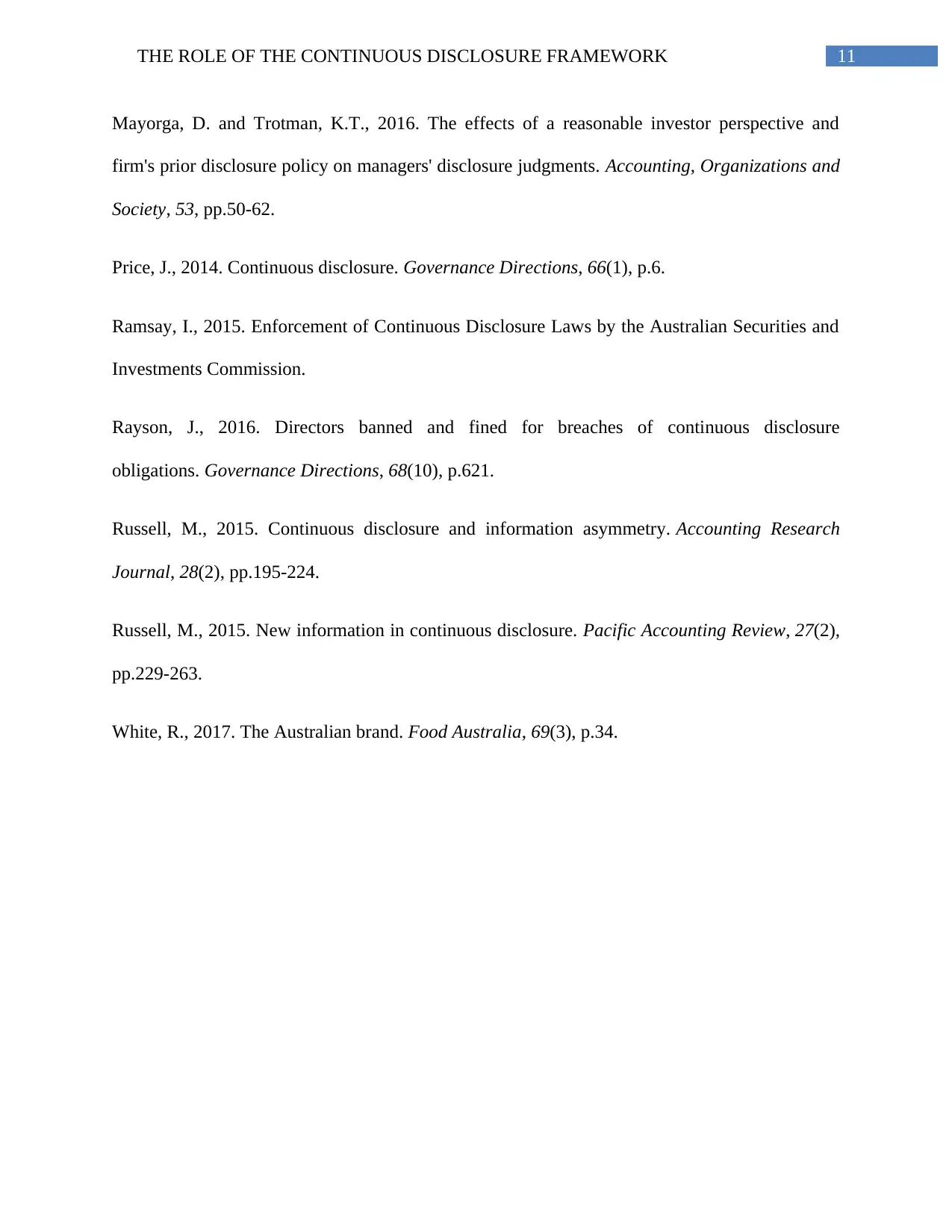
11THE ROLE OF THE CONTINUOUS DISCLOSURE FRAMEWORK
Mayorga, D. and Trotman, K.T., 2016. The effects of a reasonable investor perspective and
firm's prior disclosure policy on managers' disclosure judgments. Accounting, Organizations and
Society, 53, pp.50-62.
Price, J., 2014. Continuous disclosure. Governance Directions, 66(1), p.6.
Ramsay, I., 2015. Enforcement of Continuous Disclosure Laws by the Australian Securities and
Investments Commission.
Rayson, J., 2016. Directors banned and fined for breaches of continuous disclosure
obligations. Governance Directions, 68(10), p.621.
Russell, M., 2015. Continuous disclosure and information asymmetry. Accounting Research
Journal, 28(2), pp.195-224.
Russell, M., 2015. New information in continuous disclosure. Pacific Accounting Review, 27(2),
pp.229-263.
White, R., 2017. The Australian brand. Food Australia, 69(3), p.34.
Mayorga, D. and Trotman, K.T., 2016. The effects of a reasonable investor perspective and
firm's prior disclosure policy on managers' disclosure judgments. Accounting, Organizations and
Society, 53, pp.50-62.
Price, J., 2014. Continuous disclosure. Governance Directions, 66(1), p.6.
Ramsay, I., 2015. Enforcement of Continuous Disclosure Laws by the Australian Securities and
Investments Commission.
Rayson, J., 2016. Directors banned and fined for breaches of continuous disclosure
obligations. Governance Directions, 68(10), p.621.
Russell, M., 2015. Continuous disclosure and information asymmetry. Accounting Research
Journal, 28(2), pp.195-224.
Russell, M., 2015. New information in continuous disclosure. Pacific Accounting Review, 27(2),
pp.229-263.
White, R., 2017. The Australian brand. Food Australia, 69(3), p.34.
⊘ This is a preview!⊘
Do you want full access?
Subscribe today to unlock all pages.

Trusted by 1+ million students worldwide
1 out of 12
Related Documents
Your All-in-One AI-Powered Toolkit for Academic Success.
+13062052269
info@desklib.com
Available 24*7 on WhatsApp / Email
![[object Object]](/_next/static/media/star-bottom.7253800d.svg)
Unlock your academic potential
Copyright © 2020–2025 A2Z Services. All Rights Reserved. Developed and managed by ZUCOL.





